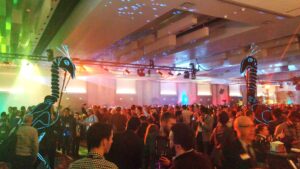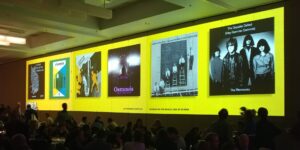
Imagine walking into your association’s annual meeting reception. The venue is alive with energy—conversations, laughter, and a high-energy band coaxing people onto the dance floor. Nearby, a family-friendly zone provides a space for children to play, while parents chat and unwind just a few feet away. If you’re seeking a quieter moment, cozy lounges are scattered throughout the venue, offering a perfect nook for networking and conversation. This reception truly creates an environment where every attendee feels comfortable.
This is the power of personalization. It’s not always about extravagant giveaways or VIP events (though those can be great when the time is right). It’s about tailoring each interaction to match the diverse needs of your audience. Personalization doesn’t have to be a complicated or expensive effort—it’s about creating opportunities for engagement that resonate with attendees’ preferences, making them feel seen and heard.
By personalizing event experiences, organizers can build lasting relationships with attendees and strengthen brand loyalty. A well-crafted experience not only boosts engagement during the event but extends the impact, keeping the connection alive long after the event has ended.
Here’s a look at how personalization is shaping modern event design and why it plays a crucial role in fostering engagement and brand loyalty.
The Growing Importance of Personalization in Event Design
According to MoEngage’s 2023 Personalization Pulse Check, 58% of North American consumers are frustrated by generic communication, and nearly one quarter prefer interactions based on their known interests and past behaviors. This data underscores a broader expectation for technology-driven personalization, where most attendees—like most consumers—want seamless, customized experiences rather than one-size-fits-all engagement.
Examples of Personalized Event Experiences
As technology evolves, the possibilities for personalizing event experiences grow. Here are a few examples that show how personalization can be integrated:
- Track Sessions: Customizing content for specific attendee groups helps increase engagement. “At our Annual Meeting, we create specific tracks, such as one for office staff,” shares Colleen Shennan, C.M.P., Assistant Director of Meetings and Continuing Education at AAPD. “We also offer content specifically tailored to our NextGen attendees.”
- Customizable Spaces: Offer distinct spaces like a vibrant “Innovation Hub” for energetic networking, a “Wellness Lounge” for relaxed, meaningful connections, and a “Family Fun Zone” with activities for kids, ensuring all attendees—from professionals to families—have the perfect environment to engage, relax, and connect.
- AI & Live Feedback: Data analytics can track attendee behaviors and preferences, allowing event organizers to tailor content and experiences in real-time.
- Personalized Digital Greetings: Interactive screens that greet attendees by name and company help foster a warm, welcoming atmosphere.
- Micro Events: Smaller, targeted experiences like breakout sessions, intimate workshops, or exclusive networking hours allow attendees to engage in a way that suits their preferences. Sponsors might host private demos, or the association could offer behind-the-scenes tours.
Personalized experiences not only make events more engaging but also entice attendees to create and post branded content. When people feel like an event is designed just for them, it naturally leads to viral social media moments, whether sharing personalized swag, a photo with a digital greeting, or a moment from an exclusive networking session. This extends the event’s reach and keeps your brand top of mind long after the event.
How to Integrate Personalization
Personalization starts with data collection during registration, but it’s essential to be transparent about how this information will be used. Respecting privacy while gathering valuable insights is key to creating a seamless and enjoyable experience.
Second, leverage data-driven insights. Once you have the necessary data, use analytics and tools like an AI-powered matchmaker to identify patterns and preferences and connect attendees. These insights will guide you in designing experiences that resonate.
Finally, design thoughtful, seamless experiences. With the right technology, you can customize schedules, content tracks, and even event layouts to suit attendee preferences. Whether it’s placing networking zones in strategic locations or curating session agendas that align with interests, personalization becomes intuitive and non-intrusive. Technology can help create an environment where attendees feel connected and engaged, enhancing their overall experience.
Personalization in Action
Each year, SPIE, the international society for optics and photonics, aims to create an opening reception that resonates with the 4,000+ scientists and engineers that attend its annual Photonics West event. Understanding the mix of personalities and preferences among its membership, the SPIE team puts in many hours over the year to curate an experience that has something for everyone. (The planning of the reception goes beyond the meetings team, with many being brought in from around the organization to help brainstorm the theme and direction.)
Over the years, attendees have been treated to themes that tie back to their professional work and allow for an experience that everyone will enjoy. A few examples include:
-

SPIE Primordial Light Opening Reception
One year, the theme of the opening reception was Primordial Light, which arose from the idea that light has existed since the dawn of time. The team built a “tree of light” in the center of the ballroom that had light glowing from the inside. The environment in the ballroom was filled with haze to make things feel like a mist filled swamp and strange characters roamed the reception.
- The following year, the event featured a Star Trek theme, which highlighted how much technology from the Star Trek movies and TV series had actually come true – and how much of that “sci-fi” tech was built with optics and photonics. Pictures, videos and quotes about technology were projected onto the airwalls and the food stations represented a different alien species (e.g., Klingon, Romulan).
- And, for another, the theme was Science of Music. SPIE took about 20 well-known albums and photoshopped the covers to change the titles into optics -and -photonics-themed and puns. These album covers were displayed all around the ballroom. Attendees were greeted by a light show in the ballroom foyer that was synced to music and quotes about the science of music were displayed on the airwalls of the ballroom.

SPIE Science of Music Opening Reception
For each reception, the SPIE team uses humor and creativity to create experiences that will not only resonate with the entire community, but also with individual attendees. When it comes to bringing the year’s theme to life, they use airwalls to segment the larger room into multiple spaces that enable each individual to experience the theme in a way that works for them. For example, they have quieter spaces for individuals who want to avoid big crowds or catch up with a friend/colleague; fun spaces with activities, such as Wii tennis with an actor playing Fabio/tennis coach, for a more interactive experience; and additional spaces with activities, such as video and pinball games, for a more subdued interactive experience.
When it comes to planning the SPIE opening reception, there is no detail – or member – left out.
Conclusion
Incorporating personalization into event experiences can transform the way attendees connect and engage, leading to stronger brand loyalty and sustained relationships. By prioritizing this strategy, event organizers can create memorable experiences that not only resonate during the event but also continue to foster meaningful connections long after it concludes.
